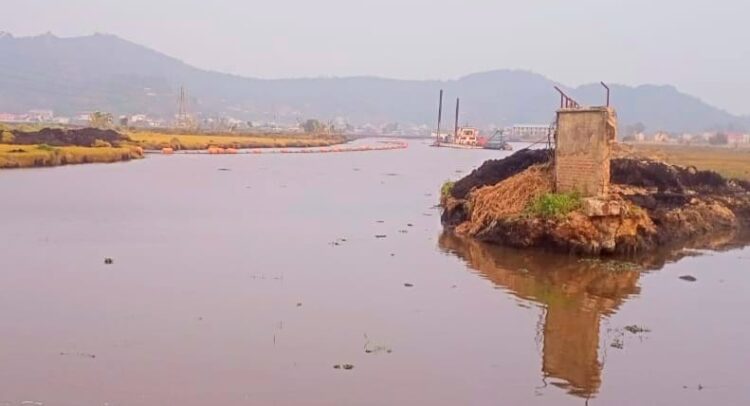Asem Bhakta Singh, Special Correspondent North East
Imphal: (Waari Singbul Network) In a landmark developmental effort, Lamphelpat, once a majestic lake in Manipur but relegated to the annals of history, is now undergoing a remarkable revival, thanks to the Rs. 650 crore Lamphelpat Waterbody Project initiated by the Water Resource Department, Manipur, in collaboration with the Ministry of Jal Shakti.
The primary objective of this ambitious project, as articulated by Remmei Alemmei, Chief Engineer of Manipur’s Water Resources Department, is to develop Integrated Flood Risk Management and ensure water security in the Imphal Valley. With a staggering water storage capacity of 124 million cubic meters, Lamphelpat Waterbody is poised to provide potable water to over 4 lakh residents of Imphal city through the Public Health Engineering Department (PHED).
Moreover, this rejuvenation endeavour is not merely about bolstering water resources; it also entails preserving the ecological integrity of the Nambul River, enhancing aesthetic values, and promoting eco-tourism potential in the Imphal city. Already, there have been promising signs of ecological revival, with increased sightings of migratory and resident birds flocking to the waterbody.
Wildlife Explorer Manipur, in collaboration with the Central Forest Division, Government of Manipur has conducted bird counts in Lamphelpat Waterbody, revealing a significant upsurge in bird population compared to previous years. This year’s count surpassed 3000 birds, indicating a marked improvement in the health of the waterbody and surrounding ecosystem.
The Wildlife Explorer reported that in the previous year of 2023, they counted 2460 birds spanning 47 species, whereas in January 2024, the count surged to 5514 birds across 32 species. This upward trend in bird numbers is indicative of the improving health condition of the Lamphelpat Waterbody.
Furthermore, their data revealed a consistent annual increase in both migratory and resident bird populations over the past three years. In 2021, the count stood at 1194 birds representing 30 species, which then rose to 3294 birds encompassing 37 species in 2022.
Remmei noted that the ongoing dredging and vegetation marsh clearing, including the removal of phumdis, is being diligently carried out by Reach Private Limited Kolkata, a Kolkata-based company.
The commendable efforts of the State Government in wetland conservation have garnered widespread acclaim. Tourangbam Brajakumar, Director of the Directorate of Environment and Climate Change of Manipur, hailed the timely action as crucial in combating the alarming decline of wetlands in the state. With only 119 wetlands remaining out of the original 550, the need for conservation efforts cannot be overstated.
Brajakumar highlighted the primary factors contributing to the decline of wetlands, including the transportation of eroded soil from deforested hills through rivers, siltation caused by improper land use practices, the encroachment of urbanization, indiscriminate dumping of urban waste into water bodies, and the overarching impact of climate change.
Brajakumar emphasized the critical importance of wetlands for ecological health, underscoring the government’s prioritization of rejuvenating six wetlands out of the 24 identified for conservation efforts. “Wetlands play a pivotal role in maintaining ecosystem balance,” he explained. “They purify the air by absorbing carbon dioxide, replenish underground water sources, mitigate flash floods, alleviate water scarcity issues, and sustain a diverse array of life forms, including humans. By preserving wetlands, we amplify these invaluable benefits.”
The Lamphelpat Waterbody Project comprises six key components, ranging from flood control measures and catchment area management to the promotion of eco-tourism activities. Beyond mitigating flood risks and ensuring climate resilience, the project aims to generate a host of socio-cultural, economic, and environmental benefits that will enrich the lives of Imphal city residents and visitors alike.
As Lamphelpat undergoes a remarkable transformation from a neglected relic to a flourishing ecosystem, it stands as a testament to the power of political conviction in conservation efforts and the unwavering dedication to preserving the natural legacy of the state—a vision championed by Chief Minister of Manipur, Nongthombam Biren Singh.


